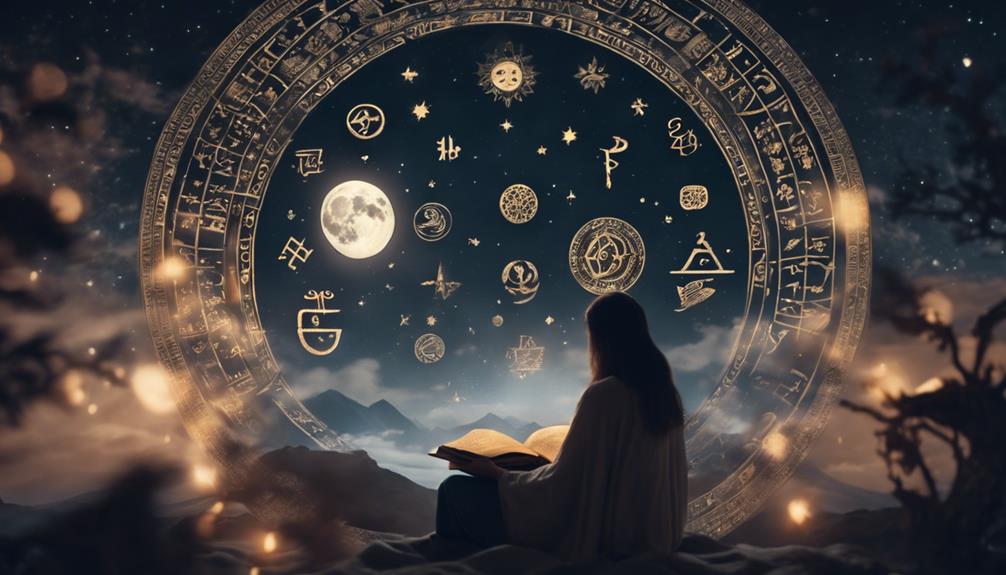Deciphering 'The Moon is Beautiful' uncovers a world of cultural, poetic, and romantic charm. It uses indirect speech to express affection and comes from Japanese literature. The moon shines as a symbol of love, purity, and shared moments, creating a dreamy atmosphere. Scientists say lunar events, like **eclipses** and **libration**, make it even more fascinating. Knowing cross-cultural ways of talking boosts the meaning of this phrase. The moon’s changing phases and sky tricks make it even more mysterious. As a sign of beauty, inspiration, and deep feelings, the moon connects different cultures. **Dive in** to find the hidden meanings and timeless magic of these words.
Key Takeaways
- Indirect communication in Japanese culture.
- Signifies deep emotions discreetly.
- Represents affection through cultural norms.
- Creates intimacy and conveys profound emotions.
- Serves as a secret language for discreet communication.
Cultural Significance of the Phrase
In Japanese culture, the phrase 'The Moon is Beautiful, Isn't It?' holds a profound cultural significance as a subtle expression of love. This Japanese expression of love signifies indirect communication, where deep emotions are conveyed without being overt. It has become a symbol of affection due to cultural norms that value understatement and subtlety in expressing feelings.
Originating in Japanese literature and pop culture, this phrase is often attributed to Natsume Soseki, a renowned Japanese writer. It serves as a secret language among individuals familiar with its significance, allowing them to communicate their love discreetly. The beauty of this phrase lies in its ability to convey profound emotions through indirect means, creating a sense of intimacy and connection between individuals.
This cultural practice highlights the importance of subtlety and nuance in Japanese communication, where words hold deeper meanings beyond their literal interpretations.
Poetic Interpretations of the Moon

Exploring the world of poetic interpretations, one finds the moon as a timeless muse, inspiring verses that whisper of love and longing under its luminous gaze. Poets throughout history have been captivated by the moon's ethereal beauty, using it as a symbol of mystery, romance, and emotion in their works.
The moon's gentle glow has often been likened to a guiding light in the darkness, offering solace and hope to those who gaze upon it. In poetic language, phrases like 'the moon's silver kiss' or 'the moon's melancholy gaze' evoke vivid imagery and deep emotions, painting a picture of love and longing that transcends time and culture.
The moon's phases, from crescent to full, are often used to symbolize the cyclical nature of life and love, adding layers of meaning to poetic expressions. Overall, the moon's presence in poetry serves as a powerful symbol of beauty, inspiration, and emotional depth.
Romantic Symbolism Associated With the Moon

The moon holds a deep connection to love and romance in Japanese culture. It's often used as a symbol of affection and intimacy, evoking images of moonlit romance.
Understanding the romantic symbolism associated with the moon can offer insight into the subtle yet profound ways emotions are expressed in Japanese society.
Moon as Love Symbol
How does the moon symbolize love in Japanese culture?
In Japanese culture, the moon is a powerful love symbol, often expressed through the phrase 'The Moon is Beautiful, Isn't It?' This phrase serves as an indirect way of saying 'I love you,' reflecting the deep emotions associated with the moon.
The moon is revered for its associations with purity, calmness, and shared human experiences, making it a fitting symbol for love. Renowned Japanese novelist Natsume Soseki popularized this expression as a subtle yet profound way to convey affection.
Understanding the moon as a love symbol enriches connections and mutual understanding, highlighting the beauty of expressing love through symbolic language in Japanese culture.
Moonlit Romance Imagery
Under the moon's soft glow, romance blossoms in the night sky, weaving tales of love and mystery.
Moonlit romance imagery is a poetic way of saying that the moon creates a romantic atmosphere where emotions are heightened and connections deepen.
In Japanese culture, the expression 'tsuki ga kirei' is often used to describe the beauty of the moon, symbolizing a deep appreciation for its romantic allure.
The moon's luminous presence has inspired countless artists, poets, and lovers to express their deepest feelings under its enchanting light.
This romantic symbolism associated with the moon transcends borders and is a universal theme that resonates with people worldwide.
Whether in literature, art, or folklore, the moon continues to be a timeless symbol of love and passion.
Scientific Insights Into Lunar Phenomena

Exploring the intricacies of lunar phenomena reveals a fascinating interplay between celestial bodies and earthly observers. Lunar phenomena encompass events such as eclipses, phases, and libration. The moon's phases are a result of its position relative to the Earth and the Sun.
Moon illusion, where the moon appears larger near the horizon than in the sky, is an enchanting aspect of lunar observation. Libration, causing slight variations in the moon's apparent size and position over time, adds to the complexity of lunar phenomena.
To truly comprehend these occurrences, one must venture into the domains of astronomy and celestial mechanics. These scientific insights provide a deeper appreciation for the phrase 'tsuki ga kirei,' which has been immortalized by the renowned Japanese writer Natsume.
The beauty of the moon, as observed through its various phenomena, is a tribute to the intricate dance between the celestial bodies and those who gaze upon them.
Cross-Cultural Exploration of Language

When exploring 'The Moon is Beautiful,' we discover the intricate dance between language nuances and cultural interpretations. This phrase, with its hidden meaning of 'I love you' in Japanese, showcases how words can carry profound symbolism beyond their literal translation.
Understanding these subtleties requires an appreciation for the rich tapestry of cultural norms and expressions.
Language Nuances
Delving into language nuances across different cultures enhances our understanding of diverse communication styles and expressions. In the case of the phrase 'The Moon is Beautiful, Isn't It?' in Japanese culture, direct translation alone may not capture its true essence. This phrase symbolizes 'I love you' and reflects the Japanese preference for indirect emotional expressions. Understanding such cultural nuances is key to grasping the depth of communication.
In Japanese society, conveying feelings subtly is often valued over explicit declarations. This showcases the intricate layers of the Japanese language and the importance of context in communication. When encountering such phrases, being aware of these nuances can lead to more accurate interpretations and meaningful interactions across cultures.
Cultural Interpretations
In understanding cultural interpretations through cross-cultural exploration of language, one can uncover profound insights into diverse communication norms and expressions.
The phrase 'The Moon is Beautiful, Isn't It?' in Japanese culture symbolizes indirect expressions of affection and love. Originating from the renowned author Natsume Soseki, this phrase serves as a subtle way to convey deep emotions without being overt.
It reflects the Japanese preference for subtle and poetic communication, where emotions are often expressed through nuanced language. By delving into the cultural context behind this phrase, one can gain a deeper appreciation for the art of indirect expressions in Japanese communication.
This cultural interpretation highlights the beauty of conveying emotions through the elegant simplicity of language.
Beauty and Mystery of the Moon

Amidst the vast expanse of the night sky, the beauty and mystery of the moon captivate our senses with an eternal allure. The moon, a symbol of illumination and guidance, has inspired art, literature, and cultural interpretations for centuries.
Across diverse cultures, the moon holds different meanings, reflecting a universal fascination and wonder. Its phases and cycles evoke emotions of transformation, mystery, and introspection, connecting us to nature and the passage of time. Artists and poets frequently use the moon as a metaphor for love, longing, and the ever-changing nature of life.
The moon's serene presence in the night sky has a profound impact on our perceptions and emotions, stirring a sense of awe and curiosity within us. Its enigmatic nature continues to spark creativity and contemplation, inviting us to ponder the mysteries of the universe and our place within it.
Shedding Light on Lunar Phases

Lunar phases shape the moon's appearance as it orbits Earth, with eight primary phases like New Moon and Full Moon. We observe the moon waxing and waning, progressing through its 29.5-day cycle.
Understanding these phases helps us track celestial events, tides, and historical traditions tied to the moon's influence.
Lunar Cycle Overview
Exploring the sky's ever-changing canvas, we observe the dance of light and shadow on the moon's surface through its eight distinct phases. The lunar cycle consists of different moon phases, each showcasing varying amounts of illumination. From the new moon to the full moon, the waxing phases display increasing brightness, while the waning phases show decreasing light.
Understanding these phases is vital for cultural practices worldwide, including religious ceremonies and agricultural activities. The moon's phases also play a role in influencing tides, animal behaviors, and human activities, highlighting the interconnectedness between nature and celestial bodies.
Moon Phase Effects
Observing the moon's phases reveals a dynamic interplay of light and shadow that influences various aspects of our world.
- Moon phases, also known as lunar phases, are the different shapes of the moon seen from Earth during its monthly orbit.
- There are eight primary moon phases, including New Moon, Waxing Crescent, First Quarter, Waxing Gibbous, Full Moon, Waning Gibbous, Third Quarter, and Waning Crescent.
- Each moon phase's appearance is determined by the positions of the Earth, moon, and sun.
- Moon phases impact natural phenomena like tides, animal behavior, and agriculture.
- Understanding moon phases is essential for celestial navigation, astrology, and cultural traditions globally.
Delving Into Celestial Illusions

As we investigate celestial illusions, one compelling phenomenon that captivates our minds is the moon illusion. This psychological phenomenon is a trick of perception that occurs when the moon appears larger on the horizon than when it's high in the sky. The moon illusion is influenced by how our brains interpret the sky, taking into account factors like contrast with surrounding objects and depth cues. It typically occurs during moonrise and moonset when the moon is closer to the horizon.
Scientific explanations suggest that the brain processes the moon's size relative to the landscape, creating the illusion of a larger moon. This phenomenon showcases how our perception can be influenced by various environmental cues, leading to the intriguing experience of the moon illusion. By understanding the science behind this celestial illusion, we gain insight into the complexities of human perception and how our brains interpret the world around us.
The Moon's Symbolism in Different Contexts

The symbolism of the moon in various cultural contexts signifies purity, calmness, and shared human experiences. The moon's beauty transcends mere appearance, evoking deep emotional responses and acting as a universal symbol of love.
Here are five ways the moon's symbolism is interpreted across different cultures:
- Romantic Love: The moon is often associated with romance and love in many societies, representing the beauty and mystery of affection.
- Spirituality: In various spiritual beliefs, the moon symbolizes enlightenment, inner peace, and the cyclical nature of life.
- Feminine Energy: Some cultures link the moon to femininity, connecting its phases to the stages of a woman's life.
- Harmony and Balance: The moon's serene presence in the night sky is seen as a reminder of the need for balance and harmony in life.
- Connection to Nature: Many view the moon as a symbol of our connection to the natural world, emphasizing the importance of preserving and respecting the environment.
Encouraging Appreciation for the Moon

Appreciating the moon's beauty goes beyond admiration; it involves understanding the subtle yet profound expressions it conveys in various cultures. In Japanese culture, the moon symbolizes indirect communication, with phrases like 'The Moon is Beautiful, Isn't It?' serving as a way to express love and deep emotions discreetly. This form of hidden language originated in Japanese literature and pop culture, notably associated with Natsume Soseki. By exploring the cultural significance behind such expressions, one can truly enhance their appreciation for the moon's beauty, viewing it not just as a celestial body but as a vessel for conveying sentiments. To investigate further into this concept, let's examine how the moon serves as a medium for indirect communication in different cultures:
| Moon Phrases | Cultural Significance | Hidden Meaning |
|---|---|---|
| 'The Moon is Beautiful…' | Japanese Culture | Expression of Love |
| 'Talking to the Moon' | Chinese Tradition | Longing and Solitude |
| 'Moonlit Serenade' | Western Romanticism | Romance and Affection |
| 'Moon Dance' | Native American Beliefs | Connection to Nature |
| 'Moon Goddess' | Greek Mythology | Feminine Power and Mystery |
Frequently Asked Questions
What Does It Mean When You Say the Moon Is Beautiful?
When we say 'the moon is beautiful,' it can convey deep emotions like love in Japanese culture. The phrase holds symbolism and roots in Japanese literature, credited to Natsume Soseki. Understanding this requires familiarity with Japanese cultural norms.
Responses like 'Shin demo ii wa' or 'Sou desu ne' indicate various levels of emotional engagement. The phrase serves as an indirect way to express profound feelings without being overt.
What Is the Poetic Meaning of the Moon Is Beautiful Isn't It?
The poetic meaning of 'The Moon is Beautiful, Isn't It?' goes beyond a simple observation. It symbolizes a profound expression of love in Japanese culture. This phrase conveys affection subtly, embracing the beauty of indirect emotional communication.
Through its poetic lens, the moon becomes a metaphor for deep emotions that words alone can't fully capture. Embracing this concept enriches connections and cultural understanding, highlighting the nuances of emotional expression.
How Do You Respond to Moon Is Beautiful Isn T It?
We respond to 'Moon is beautiful, isn't it?' by acknowledging its poetic and romantic undertones. The statement reflects appreciation for the moon's beauty and creates a shared moment of admiration.
It subtly invites agreement and connection through a mutual appreciation of nature's wonders. Understanding the nuances of this expression enhances communication and fosters a sense of shared beauty and understanding.
What Does Isn't the Moon Beautiful Mean in Demon Slayer?
When we hear 'Isn't the Moon Beautiful' in Demon Slayer, it signifies a sinister moment. Muzan's use of this phrase before transforming a girl into a demon shows his manipulative nature.
The seemingly innocent words carry a chilling undertone, showcasing Muzan's deceptive tactics.
This phrase serves as a stark contrast to its usual romantic connotation in Japanese culture, highlighting the dark themes within the anime.
What is the significance of the olive tree in relation to the beauty of the moon?
The olive tree symbolism explained meaning is deeply rooted in ancient mythology and culture. In relation to the beauty of the moon, the olive tree represents peace, fertility, and eternity. It is often associated with the moon’s serene glow, symbolizing harmony and abundance in nature.
Conclusion
To sum up, the phrase 'the moon is beautiful' holds a myriad of meanings that transcend language and culture. From its poetic interpretations to its scientific marvels, the moon continues to captivate and inspire us.
By delving into its symbolism and shedding light on its celestial illusions, we can truly appreciate the beauty and wonder of our closest cosmic neighbor.
So next time you gaze up at the night sky, remember to take a moment to marvel at the beauty of the moon.











